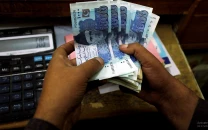Banking system assets grow 8%: SBP
The surge in resources is the most significant since 2007.

Deposits increased by 9.4%, registering the highest half-yearly growth during the last four years, the review said, adding that net investments, with an increase of 22.4% during the first half of 2011, markedly outpaced the weak growth of 1.04% in net advances.
Banks’ profits before tax were also up by 31% during the first half of 2011 to reach Rs77 billion, with return on assets of 2.1% (1.8 % in June 10) and return on equity of 21.9 % (17.7% in June 10).
During Jan-June 2011, banks remained fairly liquid on the back of growing share of investments in government papers, it said, adding that banks’ capital adequacy ratio also observed improvement, reaching 14.1% by June-2011.
However, concentration in profits dropped – the share of top five banks were down from 95% in December 2010 to 78% in June 2011- ensuring that even smaller banks have a share, albeit marginal, in industry profits.
Furthermore, growing profits have also helped reduce the number of loss making banks, from 17 in June 2010 to eight in June 2011, it said.
However, the review cautioned that source of profits is shifting away from interest income through advances to investments in government papers.
Specifically, returns from investments in government papers now accounts for almost 30% of banks’ interest income, up from 24 % in June 2010, it added.
Giving his feedback on the SBP report, Muzammil Aslam, economist at JS Global Capital Limited,
said that the growth of 8%
in assets of Pakistan’s banking system is primarily because of the lending of banks to the government, which provides them with healthy profits.
“There has been very little growth in the local private credit sector, which is a big problem. In fact, private credit growth has been at its lowest in Pakistan in the last ten years because banks are busy lending to the government and not taking risk of lending to the private sector,” he said.
“While we know that there is a strong growth in assets, we do not exactly know the growth in liabilities of banks in the period under review,” he added.
“The cost of finance is high in Pakistan which has discouraged private sector loans but now that the central bank has reduced interest rates from 14% to 12%, it is expected that banks may have to diversify their lending to private sector,” he added.
The review stressed that there has been growing evidence of banks’ flight towards quality as net investments, mainly in government securities, now constitute around 34% of banks’ assets compared with 28% in June 2010.
Credit risk remained a major challenge as banks accumulated Rs31 billion of fresh non-performing loans, pushing infection ratio from 14.7 % to 15.3%, the review said, adding that public sector commercial banks and mid-sized local private banks appear more vulnerable to higher credit risk.
Published in The Express Tribune, December 10th, 2011.



1728020501-0/Express-Tribune-Web-(13)1728020501-0-208x130.webp)















COMMENTS
Comments are moderated and generally will be posted if they are on-topic and not abusive.
For more information, please see our Comments FAQ